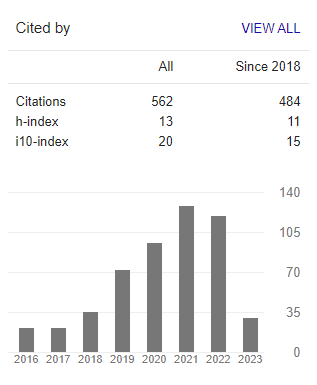INSTAGRAM DAN FENOMENA “JASTIP” DI INDONESIA
Abstract
Technological advances have now given birth to new media. The information environment arises from the simultaneous and rapidly interconnected Internet evolution of transmission systems, content, quality, and structure of the new media itself. One example of new media is social media, including Instagram. Instagram is now not only an arena for uploading photos but as a means to carry out digital marketing activities. The social media platform has developed as a form of global communication and bridges the relationship between humans and products. As time goes on, a new business model has been born on Instagram. One business model is "jastip," a synonym for entrusted services, allowing Instagram users to buy goods through providers of services that are usually different cities or countries. This article aims to find out information about "jastip," and its impact on business activities and digital marketing, especially in Indonesia.
To cite this article (7th APA style):
Muslicha, I. S. & Irwansyah (2019). Instagram dan Fenomena “Jastip” di Indonesia [Instagram and the “Jastip” Phenomena in Indonesia]. Journal Communication Spectrum, 9(2), 143-157. http://dx.doi.org/10.36782/jcs.v9i1.1871
Keywords
References
Al-Kandari, A. J., Al-Hunaiyyan, A. A. & Al-Hajri, R. (2016). The Influence of Culture on Instagram Use. Journal of Advances in Information Technology, 7(1), 54–57. https://doi.org/10.12720/jait.7.1.54-57
Alshawaf, E., & Wen, L. (2015). Understanding digital reputation on Instagram: A case study of social media mavens. Proceedings of the 2nd European Conference on Social Media ECSM 2015, (August), 19–27.
Bergstrom, T. & Backman, L. (2013). Marketing and PR in Social Media: How the utilization of Instagram builds and maintains customer relationships. Media and Communication, 14.
Biocca, F. (2000). New media technology and youth: Trends in the evolution of new media. Journal of Adolescent Health, 27(2 SUPPL.), 22–29. https://doi.org/10.1016/S1054-139X(00)00136-1
Blank, G. & Lutz, C. (2017). Representativeness of Social Media in Great Britain: Investigating Facebook, LinkedIn, Twitter, Pinterest, Google+, and Instagram. American Behavioral Scientist, 61(7), 741–756. https://doi.org/10.1177/0002764217717559
Dahlan, M. A. (2012). The New Media and Islam: Communication Characteristics and Dynamics. Journal Communication Spectrum, 2(1), 1-12
Kaplan, A. M., & Haenlein, M. (2010). Users of the world, unite! The challenges and opportunities of Social Media. https://doi.org/10.1016/j.bushor.2009.09.003
Kaufman, I. & Horton, C. (2017). Digital Marketing, Integrating Strategy and Tactics with Values. Apothesis. https://apothesis.lib.teicrete.gr/handle/11713/8242
Kutthakaphan, R., Chokesamritpol, W., Examiner, K. L. & Hallén, L. (2013). The Use of Celebrity Endorsement with the Help of Electronic Communication Channel (Instagram). Case Study of Magnum Ice Cream in Thailand, 705.
Leung, L. & Lee, P. S. N. (2005). Multiple determinants of life quality: The roles of Internet activities, use of new media, social support, and leisure activities. Telematics and Informatics, 22(3), 161–180. https://doi.org/10.1016/j.tele.2004.04.003
Wally, E. & Koshy, S. (2014). The use of Instagram as a marketing tool by Emirati female entrepreneurs: an exploratory study. Proceeding International Business Research Conference, 1–19.
Refbacks
- There are currently no refbacks.

This work is licensed under a Creative Commons Attribution 3.0 License.
Indexed by:
Archived in:
Listed in:
INTERNATIONAL ASSOCIATION FOR MEDIA AND COMMUNICATION RESEARCH

















